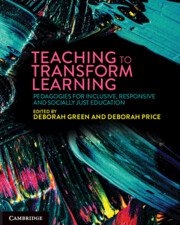Book contents
- Teaching to Transform Learning
- Acknowledgement of Country
- Teaching to Transform Learning
- Copyright page
- Contents
- Contributors
- Acknowledgements
- Introduction Understanding the learner to inform educators’ implementation of pedagogical approaches to transform learning
- Part 1 Pedagogies for all
- Part 2 Engaging pedagogies: making the curriculum come alive for all learners
- Part 3 Empowering pedagogies: 21st-century skill development and 22nd-century futures thinking
- 15 Understanding the world through transdisciplinary inquiry
- 16 Citizenship education: a relational approach
- 17 Flipping constructivist pedagogies to enable the equal intensity of depth and breadth in learning
- Index
- References
16 - Citizenship education: a relational approach
from Part 3 - Empowering pedagogies: 21st-century skill development and 22nd-century futures thinking
Published online by Cambridge University Press: 25 October 2024
- Teaching to Transform Learning
- Acknowledgement of Country
- Teaching to Transform Learning
- Copyright page
- Contents
- Contributors
- Acknowledgements
- Introduction Understanding the learner to inform educators’ implementation of pedagogical approaches to transform learning
- Part 1 Pedagogies for all
- Part 2 Engaging pedagogies: making the curriculum come alive for all learners
- Part 3 Empowering pedagogies: 21st-century skill development and 22nd-century futures thinking
- 15 Understanding the world through transdisciplinary inquiry
- 16 Citizenship education: a relational approach
- 17 Flipping constructivist pedagogies to enable the equal intensity of depth and breadth in learning
- Index
- References
Summary
This chapter introduces you to a relational approach to citizenship education, one that is grounded in how educators can and do engage children in coming together to interact with and learn from others in their communities. In this chapter, we are interested in a broad understanding of citizenship education, one which might be better understood as education for citizenship. While commonly understood as either a ‘status’ or a ‘practice’, this chapter argues that citizenship, above all else, concerns relationships. Recognising this fact requires us as educators to consider how civic relationships have been and are (often problematically) framed and how relational pedagogies can recognise and draw upon learners’ existing civic dispositions, might develop those civic dispositions further, and can build civically responsive educational settings. The chapter will provide a critical overview of relevant existing research on citizenship education before developing key features, including key pedagogical features, of a relational approach to citizenship education.
Keywords
- Type
- Chapter
- Information
- Teaching to Transform LearningPedagogies for Inclusive, Responsive and Socially Just Education, pp. 258 - 271Publisher: Cambridge University PressPrint publication year: 2024

